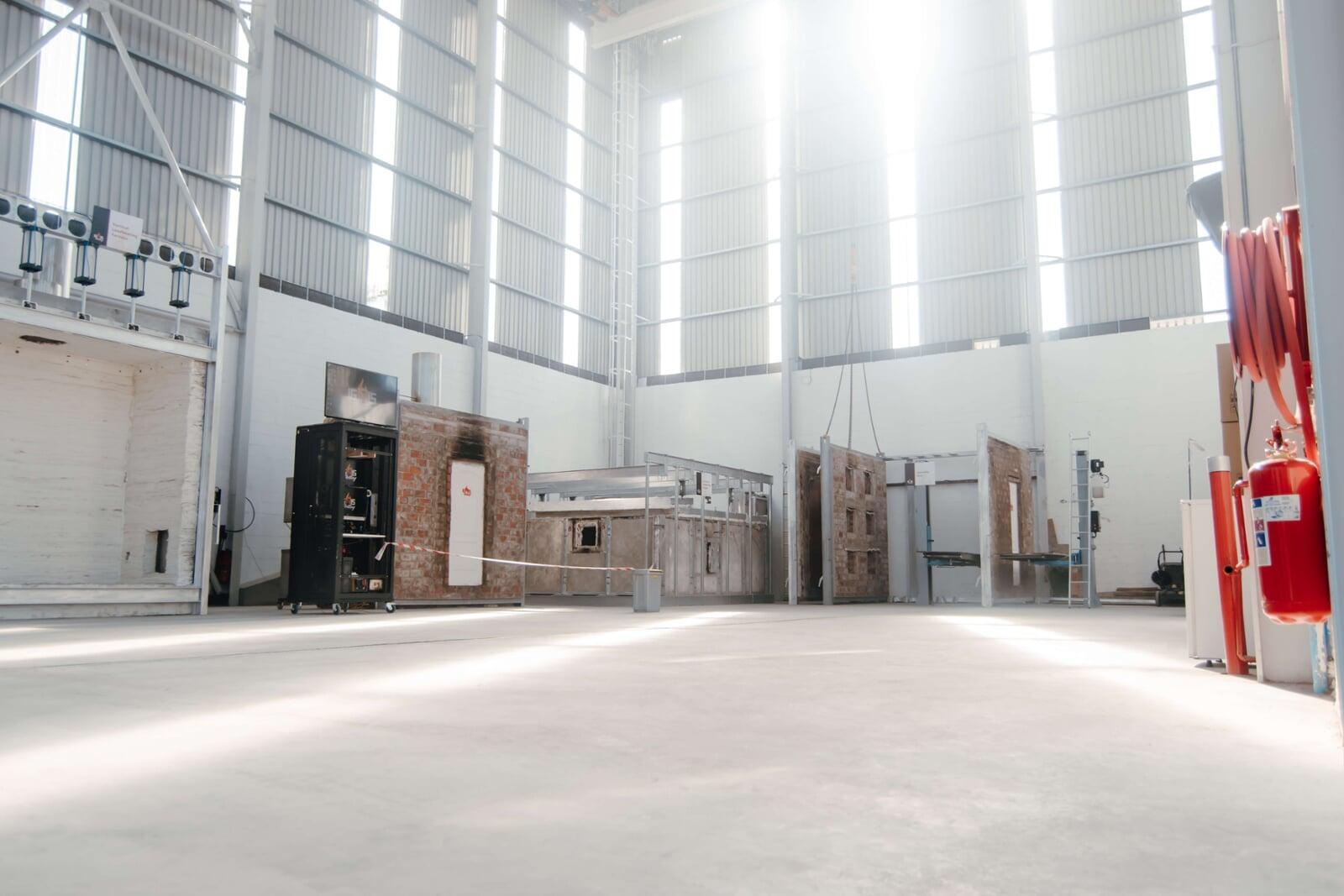A critical aspect of building safety is understanding how materials and structural elements perform in the event of a fire, especially when subject to loading. Load-bearing fire tests are essential evaluations that help ensure the load-bearing elements within a building – such as walls, floors, beams, and columns – can withstand fire while maintaining structural stability and integrity.
At Ignis Fire Testing, we specialise in conducting comprehensive load-bearing fire tests that contribute to safer, more resilient structures. According to our extensive research, no other facility on the continent performs these crucial tests.
Here is an in-depth look at what these tests involve, why they are necessary, and the benefits they provide.
Load-bearing fire tests evaluate how structural elements respond to fire when subject to the self-weight of the structure and imposed loads, also known as live loads. These tests go beyond standard fire resistance tests by simulating the structural capacity of elements at elevated temperatures, representing real-life scenarios in which walls, floors, or beams are exposed to fire while holding up parts of a building.
Prof Richards Walls from Stellenbosch University’s Fire Engineering Research Unit (FireSUN) explains, “During a fire, a loaded structural element distorts, meaning that building components can literally fall apart due to the combination of heat and force. Hence, testing walls and other systems under load helps us understand what would happen in a more realistic situation. Thus, loaded furnace tests give a more accurate assessment of a building’s components.”
During a load-bearing fire test, a test specimen, such as a wall or floor section, is constructed into a furnace (horizontal or vertical) and exposed to elevated temperatures, often reaching over 1000°C depending on the heating curve and test duration. Simultaneously, a load is applied, simulating load-bearing elements in practice, and the specimen is monitored to see how long it can resist the fire without collapsing or allowing fire spread. The results indicate whether the material can retain its structural strength and load-bearing capacity, providing vital insights into its performance during a fire.The primary goal of load-bearing fire testing is to verify that structural elements can remain structurally sound under load when exposed to elevated temperatures, reducing the risk of collapse in an actual fire event. This test focuses on:
Stability: The test assesses whether a system or element can resist the loads it is subjected to under extreme heat without buckling, collapsing, or deflecting until exceeding limits.
Insulation: Load-bearing fire tests help determine whether the material can contain the fire by limiting heat transfer to other parts of the structure, reducing the spread of flames and providing additional time for evacuation.
Integrity: Another criterion is the ability of the system to contain the fire in a fire compartment – i.e., the system has no openings that spread flames on its unexposed surface.
Compliance and certification: Most building codes require materials and structures to meet fire safety standards. Load-bearing fire tests provide the necessary data for accreditation, ensuring that construction materials comply with these stringent safety standards.
Fire can have a devastating effect on buildings, compromising structural elements that bear heavy loads. In such scenarios, the collapse of a load-bearing wall or floor could significantly impact safety, particularly if it occurs in multi-story structures. Load-bearing fire tests are a measure of understanding if structural elements can resist a fire under loaded conditions, giving occupants a critical window for evacuation and enabling firefighters to address the blaze safely.
By performing load-bearing fire tests, Ignis Fire Testing provides valuable technical information for engineers to make informed decisions about material selection, reinforcing a building's resilience to fire and improving occupant safety.Ignis can perform static and pneumatic load-bearing fire tests in our vertical (3m x 3m) and horizontal (4m x 5m) furnaces.
We started by performing static load tests, such as vertical load-bearing tests on wall panels.
Subsequently, we changed to pneumatic applied loading – a method of applying force or pressure to a structure or material using compressed air rather than static weights. This approach enables more controlled, adjustable, and often higher force loads on the test structure, which is useful in simulating the different loads that might occur in real-life situations. The pressure can be increased or decreased as needed, providing flexibility to simulate different load conditions that may shift or intensify during a fire.
An example of pneumatic load-bearing tests that we performed includes testing of load-bearing flooring systems in our horizontal furnace.
However, this is not where it ends. We are in the process of building a new horizontal furnace to accommodate up to 5m x 4m decks and 5m load-bearing beam testing. This furnace can be adjusted to accommodate various sample sizes.
At Ignis Fire Testing, our commitment to safety is grounded in rigorous testing and high standards.
Our loadbearing fire tests provide several benefits:
Reliable data for informed safety decisions regarding materials and designs
Improved compliance with safety regulations
Reduced risk of catastrophic structural failure leading to loss of life and damage to property
Enhanced market confidence in tested materials
As buildings grow taller and architectural designs become more complex, the importance of fire testing only increases. Ignis Fire Testing is dedicated to staying at the forefront of testing technology, adapting to evolving standards and helping to establish new benchmarks in fire safety. Our commitment to rigorous, accurate load-bearing fire testing ensures that we contribute to a safer future for everyone, especially on a continent where this type of testing is not prioritised.
